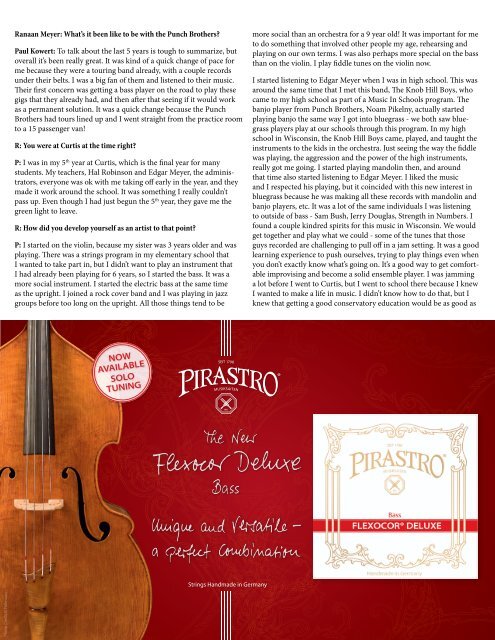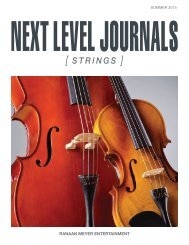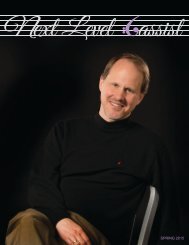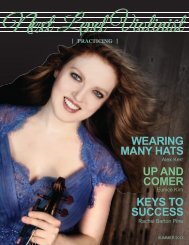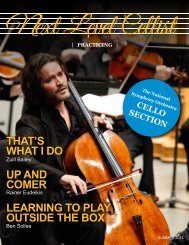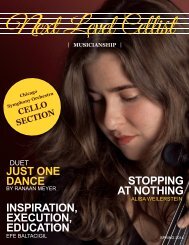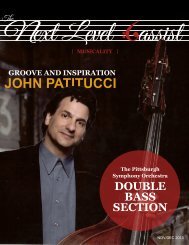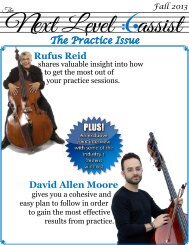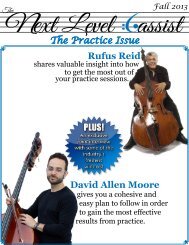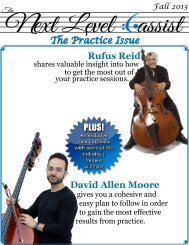Next Level Bassist Left Hand
Summer 2014 edition of Next Level Bassist. Left hand techniques and exercises by Nicholas Walker, Jordan Anderson, Paul Kowert. Section Spotlight on Cleveland Orchestra. Up and Comers Tim Dilenschneider and Jordan Morton
Summer 2014 edition of Next Level Bassist. Left hand techniques and exercises by Nicholas Walker, Jordan Anderson, Paul Kowert. Section Spotlight on Cleveland Orchestra. Up and Comers Tim Dilenschneider and Jordan Morton
Create successful ePaper yourself
Turn your PDF publications into a flip-book with our unique Google optimized e-Paper software.
Ranaan Meyer: What’s it been like to be with the Punch Brothers?<br />
Paul Kowert: To talk about the last 5 years is tough to summarize, but<br />
overall it’s been really great. It was kind of a quick change of pace for<br />
me because they were a touring band already, with a couple records<br />
under their belts. I was a big fan of them and listened to their music.<br />
Their first concern was getting a bass player on the road to play these<br />
gigs that they already had, and then after that seeing if it would work<br />
as a permanent solution. It was a quick change because the Punch<br />
Brothers had tours lined up and I went straight from the practice room<br />
to a 15 passenger van!<br />
R: You were at Curtis at the time right?<br />
P: I was in my 5 th year at Curtis, which is the final year for many<br />
students. My teachers, Hal Robinson and Edgar Meyer, the administrators,<br />
everyone was ok with me taking off early in the year, and they<br />
made it work around the school. It was something I really couldn’t<br />
pass up. Even though I had just begun the 5 th year, they gave me the<br />
green light to leave.<br />
R: How did you develop yourself as an artist to that point?<br />
P: I started on the violin, because my sister was 3 years older and was<br />
playing. There was a strings program in my elementary school that<br />
I wanted to take part in, but I didn’t want to play an instrument that<br />
I had already been playing for 6 years, so I started the bass. It was a<br />
more social instrument. I started the electric bass at the same time<br />
as the upright. I joined a rock cover band and I was playing in jazz<br />
groups before too long on the upright. All those things tend to be<br />
more social than an orchestra for a 9 year old! It was important for me<br />
to do something that involved other people my age, rehearsing and<br />
playing on our own terms. I was also perhaps more special on the bass<br />
than on the violin. I play fiddle tunes on the violin now.<br />
I started listening to Edgar Meyer when I was in high school. This was<br />
around the same time that I met this band, The Knob Hill Boys, who<br />
came to my high school as part of a Music In Schools program. The<br />
banjo player from Punch Brothers, Noam Pikelny, actually started<br />
playing banjo the same way I got into bluegrass - we both saw bluegrass<br />
players play at our schools through this program. In my high<br />
school in Wisconsin, the Knob Hill Boys came, played, and taught the<br />
instruments to the kids in the orchestra. Just seeing the way the fiddle<br />
was playing, the aggression and the power of the high instruments,<br />
really got me going. I started playing mandolin then, and around<br />
that time also started listening to Edgar Meyer. I liked the music<br />
and I respected his playing, but it coincided with this new interest in<br />
bluegrass because he was making all these records with mandolin and<br />
banjo players, etc. It was a lot of the same individuals I was listening<br />
to outside of bass - Sam Bush, Jerry Douglas, Strength in Numbers. I<br />
found a couple kindred spirits for this music in Wisconsin. We would<br />
get together and play what we could - some of the tunes that those<br />
guys recorded are challenging to pull off in a jam setting. It was a good<br />
learning experience to push ourselves, trying to play things even when<br />
you don’t exactly know what’s going on. It’s a good way to get comfortable<br />
improvising and become a solid ensemble player. I was jamming<br />
a lot before I went to Curtis, but I went to school there because I knew<br />
I wanted to make a life in music. I didn’t know how to do that, but I<br />
knew that getting a good conservatory education would be as good as<br />
NOW<br />
AVAILABLE<br />
SOLO<br />
TUNING<br />
Strings <strong>Hand</strong>made in Germany<br />
Photo Credit © Pöllmann<br />
22 SUMMER 2014 NEXT LEVEL BASSIST


